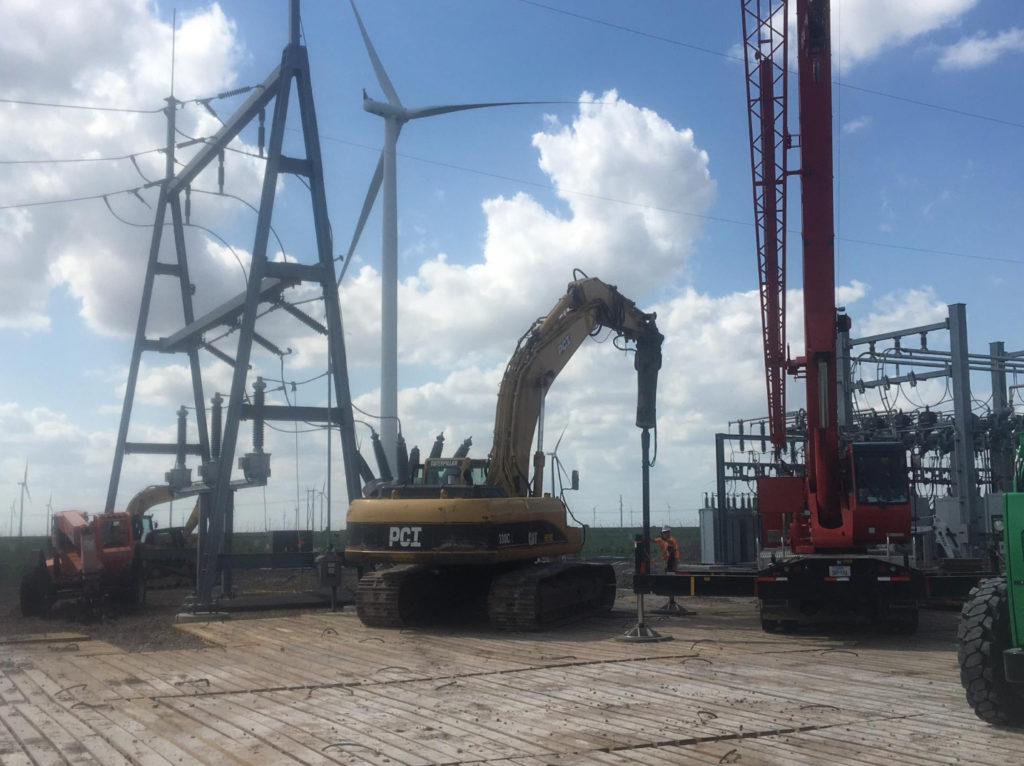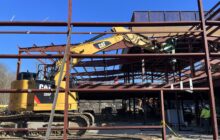Project Description:
Expansion of the Los Vientos Wind Farm in rural south Texas required an upgrade to the existing transformers at two separate substation locations. The project team planned to demo the existing drilled-shaft supported concrete substation mat, install new foundations and construct each of the newly-expanded substations within a one month shut-down period at each location.
Geotechnical Details:
Subsurface conditions encountered at the sites were generally similar and consisted of 20 to 25 feet of very soft to stiff clay and very loose to medium dense sand followed by medium dense to dense sand to depths of 55 to 60 feet. Groundwater was about 10 feet below grade.
Project Challenges:
Provide a rapidly-installed piling system to support the foundation loads while reducing risks for delays associated with grout curing, material delivery and system performance.
Advantages
- Low cost and ease of mobilization
- Development of capacity in friction
- Cost savings compared with steal H-piles
- Rapid and safe installation procedure
- Eliminated need for continuous grout supply during installation
Design and Construction Solution
The increased load of the new transformers drove the need for enlarging the existing substation foundations. A limited shutdown window of 30 days was planned to complete all work at each site. To reduce the potential for delays associated with logistical challenges of tying into the existing foundations, designers opted to demolish the existing mat foundation, install new foundations and construct the new substation. However, the limited duration construction window left little room for curing of foundation elements (i.e. drilled shafts, augercast piles, etc) or delays with material delivery or performance issues.
Working closely with the designers and general contractor, DuroTerra and Ground Improvement Engineering proposed a Ductile Iron Pile system installed through the soft soils to develop frictional capacity along the pile shaft in the very dense sand below 25 feet. The roughened surface of the Ductile Iron Pile provides very efficient development of frictional capacity compared with smooth steel H-piles or pipe piles. In addition, the bell-spigot connections of the Ductile Iron Piles allow for additional pile lengths to be easily added in the field to accommodate variable ground conditions or the need for more shaft capacity based on load test results.
Structural designers required a pile working capacity of 30 tons for mat support. A Series 170/9.0 (170 mm OD with 9 mm wall thickness) Ductile Iron Pile with a design length of 50 feet was specified for the work. The pile met the 30 ton working capacity without the need for interior grout. This allowed the system to be load tested immediately after installation to verify capacity and save time. Load testing performed at the site of the first substation showed a nearly linear load-deflection response with 0.16 inches at 60 kips (100%) and 0.38 inches at 120 kips (200%). Following load testing, the production pile installation was immediately started at the first site.
A total of 28 piles were installed in 3 days at the first substation. The second site required 36 piles and installation was also completed in 3 days. Following installation, the piles were filled with grout to provide corrosion protection – though the grout was not needed for strength so construction followed immediately after installation.
The use of the Ductile Iron Pile system on these sites substantially reduced the schedule for deep foundations as compared with any grouted foundation option (i.e. drilled shafts, augercast piles, grouted helical piles). The mobile excavator used for pile installation also easily enabled pile installation around the excavated work area. With the Plug and Drive connection system, the Ductile Iron Piles also reduced the risk for delays associated with variable ground conditions requiring additional (longer) piling materials.
Project Team Members
DIP Installation Partner: Peterson Contractors, Inc.
DIP Design Partner: Ground Improvement Engineering, Inc.
Geotechnical Engineer: Mott MacDonald
Structural Engineer: Mott MacDonald
General Contractor: Wanzek Construction
Owner: Duke Energy






